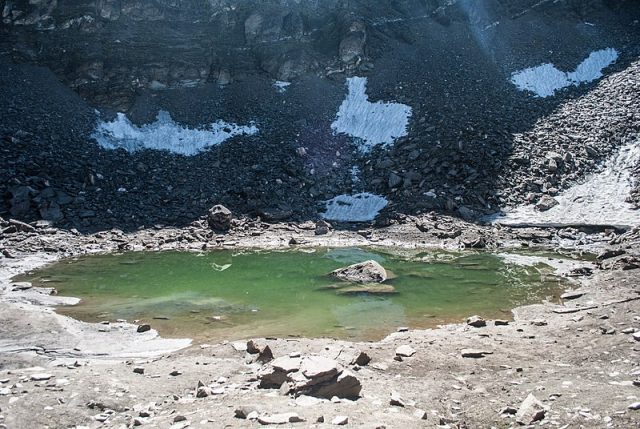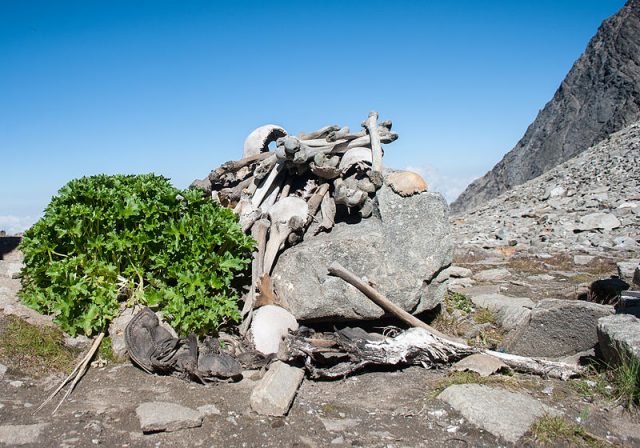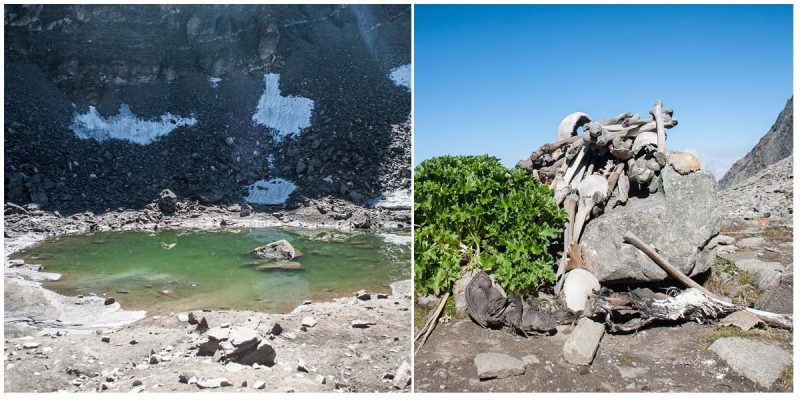It is rather unnerving to stand over a lake and see a huge pile of skulls and bones tangled up under the water’s surface. You’re left wondering who are they, and most importantly how they got here in the first place, for this lake is 16,000 feet above sea level with nothing but ice peaks and frozen glaciers surrounding it.
This frozen, shallow lake, tucked away deep in the Indian Himalayas, offers such a sight every year when the ice melts and reveals the human remains of more than 300 unfortunate individuals who rest at the bottom of Roopkund, better known as Skeleton Lake.
This “splendid” view is available to any trekking enthusiast who would dare to walk the steep route that climbs out from the heart of Lohajung’s dark forest in Uttarakhand, India, and pursue the five-day trekking adventure up to the glacial lake that sits frozen for most of the time in a small valley high up in the Garhwal part of the Himalayas.

However, for one month, when the temperature is friendly enough, the ice starts to melt and the surface starts to be see-through. Then, the bottom of the lake that is six feet at its deepest point shows what lies beneath this small and seemingly typical natural wonder. It’s a death pit full of skeletons and not just that, but hair, nails, spears, knives, and jewelry, preserved by the frost as if it was only a few years since these souls met their demise and mysteriously found their way to the bottom of this lake.
Scientists, anthropologists, and historians have tried to unravel this mind-boggling mystery. In 1942, when the lake’s contents was first discovered by a British forest ranger, they were believed to be recent humans remains of unfortunate Japanese soldiers passing through the mountains. The ranger stumbled on a human skull peeking through the snow just outside of the lake, so based on how it was preserved with a full set of hair, he simply assumed the most likely scenario. When he shortly found more bones nearby and skeletons below the frozen surface of the lake, he filed a report.
And at first his assumptions seemed logical. But no investigation was made about the bones and no one knew who they were, how long they had been there, nor what had happened for that matter. So clearly, in times when a war was still raging, the authorities shared the same initial belief that these were the remains of a military battalion passing by through the mountains toward India. But after a more thorough investigation on site, when spears and all kinds of different ancient weapons and trinkets were found lying right next to the bones, all those first impressions went down the drain and it was clear that a full study of the remains needed to be done.
For a time, the mystery remained unsolved and many theories about what had happened were set in motion. Landslides, epidemic, and ritual suicides were only a few of them. People even went as far as to accept a local belief about an ancient goddess laying waste to a group of people who defied her. According to the legend, this goddess was so infuriated by a group of travelers who dared to pass and tarnish her intact sanctuary up in the mountains that she flung iron-like hailstones over these petty disrespectful humans, killing them on the spot.
Which was actually not so far from the truth, for recent studies found clear marks of round-shaped blows to the skulls and their shoulders as if they were struck from above.
An expedition led by a team of Indian scientists with a couple of Europeans went to the lake in 2004 in order to take samples and investigate. With the advancement of DNA testing, it was now possible to examine the bones and some of the preserved human tissue. The popular opinion was that the skeletons were the remains of individuals who died from harsh weather and sudden storms over the years on the mountains and slid with the snow into the lake, which prevented the natural process of decomposition.
However, while they found the bodies differentiated in terms of height and body type, the Oxford University Radiocarbon Accelerator Unit in the United Kingdom found almost all of the remains to be from the same time, around 850 A.D. Moreover, they found two distinct body types with similar DNA. One group of shorter individuals with smaller and thinner bones, and one completely the opposite. Which led them to believe that it must have been a group on pilgrimage or some kind of expedition in the mountains that hired some local guides. Unfortunately for them, trapped in a valley and with shelter nowhere to be found, a baseball-size hail storm killed them on their way. At least, that is according to the latest scientific research.

According to the traditional Himalayan legend of the ancient goddess, a king was traveling with his pregnant wife, his family, their servants, his musicians, and several others who wished to join them on a pilgrimage to the Uttarakhand’s Nanda Devi Raj Jat festival in India that only happen once every 12 years. They hired locals to help them get there, but along the way, and despite locals telling them otherwise, they angered the goddess Nanda Devi with their loudness and were punished for it. But most of all, within the group there was a pregnant woman who allegedly gave birth on the goddess’s sacred land. According to local customs, a newborn was the greatest sin of all, so she sent out a storm of hailstones “hard as iron” and killed them.
While we don’t believe this was the wrath of a goddess, it certainly was the fury of something that killed these hundreds of people.
A legend at least in part explained the mystery long before science did. That is, until further notice and more investigation shows something entirely different. A scientific or academic institution should pursue this, for unfortunately every trekking passer-by picks up a bone or two as a souvenir, and very shortly there might be nothing left to be studied.
